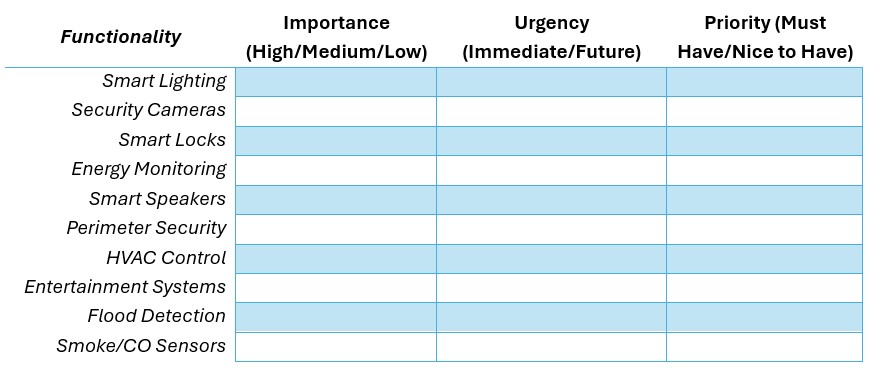Introduction
Smart homes have become increasingly accessible, offering improved convenience, security, and energy efficiency. However, selecting the right tools requires more than just evaluating features and prices. This guide provides a fresh approach to building an economic home automation system tailored to your needs, emphasizing cost, functionality, long-term value, and critical considerations such as security, autonomy, and vendor lock-in.
Why Automate Your Home?
Before diving into the technical aspects, it’s essential to understand why you want to automate your home. Home automation can serve multiple purposes:
- Convenience: Simplifying everyday tasks like turning off lights or locking doors.
- Security: Enhancing safety with smart locks, cameras, and sensors.
- Energy Efficiency: Reducing power consumption through automated lighting and HVAC control.
- Entertainment: Creating immersive experiences with smart speakers and home theater integration.
- Accessibility: Assisting individuals with limited mobility or specific needs.
To make informed decisions, it’s vital to focus on the foundations of scalability, security, and ease of use before diving into specific device configurations.
Key Principles for Building a Solid Automation System
1. Prioritize Scalability and Long-Term Support
- Start with a platform that can grow with your needs, such as Home Assistant (HA). It integrates devices across ecosystems, allowing for flexibility and future-proofing your setup.
- Choose hardware with reliable performance and long-term support. Mini-PCs or Intel NUCs running HAOS (Home Assistant OS) are excellent choices, providing balance between power and cost.
2. Focus on Security and Reliability
- Enable features like multi-factor authentication (MFA) and IP bans to secure your system. Platforms like Home Assistant make implementing these practices straightforward.
- Avoid relying on SD cards for HA installations. Use SSDs or NVMe drives to ensure durability and avoid data loss.
- Perform regular backups, using tools like the Google Drive add-on, to protect your data and simplify recovery if needed.
3. Balance Local and Cloud Solutions
- Local-only systems, such as HA combined with Zigbee or Z-Wave, offer better privacy and lower recurring costs. They also operate independently of internet disruptions.
- Cloud-based systems provide ease of setup but may involve higher costs and potential vendor lock-in. Home Assistant bridges the gap by integrating cloud and local devices seamlessly.
4. Start Small and Plan for Growth
- Begin with essential devices, such as smart lighting and locks, and gradually expand to include more advanced features like energy monitoring or perimeter security.
- Configure your automation platform for optimal performance before adding integrations. Rushing to connect devices can lead to inefficiencies and troubleshooting headaches.
5. Simplify Maintenance
- Regularly update your system to ensure security and access to the latest features. Follow release notes to address any breaking changes proactively.
- Utilize community tools like HACS (Home Assistant Community Store) for custom integrations and themes to enhance functionality without overcomplicating management.
Functionality Checklist

1. Lights and Switches
- Options: Philips Hue, Wyze, Sengled, TP-Link Kasa, Lutron Caseta.
- Considerations: Zigbee-based systems like Philips Hue are energy-efficient and reliable but require a hub. Wi-Fi systems like Wyze are simpler to set up but consume more power.
2. Smart Speakers
- Options: Amazon Echo, Google Nest Mini, Apple HomePod Mini.
- Considerations: Choose based on your preferred ecosystem and privacy concerns. Google Nest and Amazon Echo integrate seamlessly with HA.
3. Door Locks and Garage Openers
- Options: August Smart Lock, Wyze Lock, Chamberlain MyQ, Yale Assure Lock.
- Considerations: Wi-Fi locks are easy to install but require frequent battery replacements. Zigbee or Z-Wave options offer better reliability and integrate smoothly with HA.
4. Cameras and Security
- Options: Wyze Cam, Arlo Pro, Google Nest Cam, Eufy.
- Considerations: Wyze is budget-friendly, while Arlo and Nest offer premium features. Integrate with HA for improved privacy and centralized control.
5. Perimeter and Environmental Monitoring
- Options: Aqara sensors, SimpliSafe, Eufy.
- Considerations: Opt for systems with local control to reduce dependence on cloud services and subscriptions.
Final Recommendations
- Choose a Strong Foundation: Use Home Assistant as the core platform to manage both local and cloud-integrated devices.
- Think Long-Term: Invest in reliable hardware and avoid vendor lock-in by selecting open systems with active community support.
- Start Small: Focus on must-have devices initially and expand as your confidence and requirements grow.
- Stay Secure: Implement best practices like regular backups, secure logins, and robust hardware to minimize risks.
Additional Resources
- Home Assistant Getting Started Guide
- Wirecutter’s Best Smart Home Devices of 2024
- Reddit Smart Home Community
By following these principles and carefully selecting components, you can build a scalable, secure, and cost-effective smart home tailored to your needs.
Are you ready to transform your technology into a growth driver? Let Jaime Munera Consulting help you navigate the complexities of IT, cybersecurity, and IoT with confidence.
Together, let’s shape a smarter, safer, and more connected future for your business.
